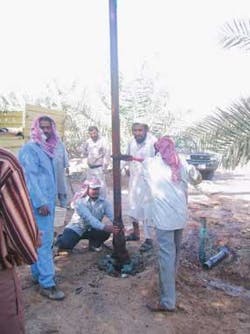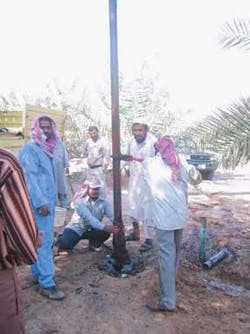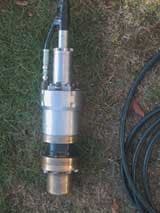New technique rejuvenates abandoned wells
By Craig Somerville
Initial tests of the new Airburst® technology in Abu Dhabi improved water well capacity tremendously, far surpassing the expectations of the municipality staff, who are trying to rejuvenate some of the country's 70,000 water wells.
The Emirate of Abu Dhabi invited Cirrus International's local partner, Specialised Technical Services Est (STS) to tests its technology on some problem wells in the Abu Dhabi Municipality. Other techniques had been tested, but resulted in little or no success; however AirBurst increased well capacity in the tested wells from zero flow to almost full operation.
The success of the initial work prompted further trials with similar results. AirBurst even rejuvenated one unproductive, abandoned well.
High consumption and overexploit-ation threaten groundwater resources in the emirate, which relies primarily on groundwater for drinking and irrigation.
The deposition of silt, minerals and bacteria gradually blocks screened and unscreened wells, which results in lower production (specific capacity) and increased pumping costs due to wasted energy and maintenance costs. As a result, water authorities in Abu Dhabi must rehabilitate the well or drill replacements. Government policy does not allow the drilling of new wells.
New well development simply exacerbates the problems of overexploit-ation, whereas rehabilitation enables managers to grasp a clearer understanding of the groundwater status so that its management can be more effective. For example, lowering well production may not be a result of well blockage. It may be an indication of a lowering water table with potentially serious results.
A variety of methods have been used for many years to help rejuvenate water wells. Their results vary in success, and the time taken to implement is frequently extensive.
The new technique, Airburst, uses air as the "explosive" by using a specially modified tool, which can be repeatedly fired along the well screen or producing area. The AirBurst tool configuration and operation are tailored to the well dimensions and construction by controlling pressures up to 3,000 psi and tool size allows energy equivalents of a few grams of dynamite to over half a kilo!
The almost instantaneous release of air displaces the surrounding water causing a high pressure wave front that extends through and beyond the well face or screen and far into the producing area. The bubble then contracts, implodes and creates a negative pressure wave drawing the obstructing material into the body of the well. Typically, a well would be video-surveyed before treatment and the tool would be "fired" regularly within the screen or producing area at intervals of four to 10 seconds. The whole operation usually takes around one to two hours.
Initially developed in the USA, AirBurst is available worldwide through Cirrus International and Frazier Industries. Patents have been granted in the European Union, Australia and the USA. Other patents are under application worldwide.
Author's Note
Craig Somerville is the managing director at Cirrus International, based in Cheltenham, England.
One problem well originally supplied 25 m3/hr of groundwater to three farms in the Subaka area of Abu Dhabi, but well capacity decreased over years of use to almost zero due to sand and bio fouling. The 129-ft-deep well, 12-inch-diameter well used a KSB Type BPD 242/7 pump with a capacity of 23 m3/hr at 70m head. Engineers inspected the well using a Pearpoint system that includes a 300-ft solid rod with 455 bi-directional camera.
Water flowed from the well, but would then stop, leading engineers to assume a malfunctioning pump. Onsite inspection, however, confirmed that the static water level remained above the pump, and that water could be pumped manually in a "start-stop" fashion for an extended period. A video inspection of the well and casing showed clearly that the filter slots, which were cut in the casing from 85ft to 124ft were completely blocked in most instances.
STS deployed the AirBurst tool down the well to the base of the blocked filter slots. Some 80 airburst shots were performed in both directions over the filter area in 40 minutes.
Upon completion, a video inspection showed that the slots had in the main been cleared and that water flowing easily into the well was now full of sand and other debris pulled from the slots and surrounding area. Water was seen flowing through the slots freely. It was immediately apparent that water flow improved dramatically after the pump and riser were reinstalled.


